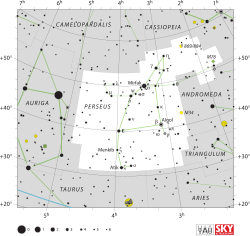29 Persei
| 29 Persei | |
 | |
| Observationsdata Epok: J2000.0 | |
|---|---|
| Stjärnbild | Perseus |
| Rektascension | 03t 18m 37,74077s[1] |
| Deklination | +50° 13′ 19,8341″[2] |
| Skenbar magnitud () | +5,16[3], +5,157 ± 0,009(V)[2] |
| Stjärntyp | |
| Spektraltyp | B3 V[4], |
| U–B | -0,56[5] |
| B–V | -0,073 ± 0,004[6] |
| Astrometri | |
| Radialhastighet () | -1,50 ± 0,9[7] km/s |
| Egenrörelse (µ) | RA: 23,574 ± 0,331[1] mas/år Dek.: -24,407 ± 0,284[1] mas/år |
| Parallax () | 5,12 ± 0,29[1] |
| Avstånd | 640 ± 40 lå (200 ± 10 pc) |
| Absolut magnitud () | -1,31[8] |
| Detaljer | |
| Massa | 6,8[9] M☉ |
| Radie | 3,9[10] R☉ |
| Luminositet | 960[8] L☉ |
| Temperatur | 16 143[8] K |
| Metallicitet | 0,00 (Fe/H)[11] dex |
| Vinkelhastighet | 120[12] km/s |
| Andra beteckningar | |
| GSC 03319-02073, 2MASS J03183775+5013200, UBV 3170, AG+50 356, HD 20365, PPM 28374, UBV M 40912, BD+49 899, HGAM 197, ROT 446, uvby98 520200383, Melotte 20 383, HIC 15404, SAO 23944, WEB 2962, GC 3934, HIP 15404, SKY# 4970, ZZ2002 93, GCRV 1819, HR 987, TD1 2045, Gaia DR2 442550823139950080, GEN# +5.20200383, IRAS 03150+5002, TYC 3319-2073-1[2][13] | |
29 Persei, som är stjärnans Flamsteed-beteckning, är en ensam stjärna[14] belägen i den norra delen av stjärnbilden, Perseus. Den har en skenbar magnitud på ca 5,16[3] och är svagt synlig för blotta ögat där ljusföroreningar ej förekommer. Baserat på parallax enligt Gaia Data Release 2 på ca 5,1[1] mas, beräknas den befinna sig på ett avstånd på ca 640 ljusår (ca 200 parsek) från solen. Den rör sig närmare solen med en heliocentrisk radialhastighet av ca –1,5 km/s.[7] Stjärnan ingår i stjärnhopen Alfa Persei.[15][16]

Egenskaper
29 Persei är blå till vit stjärna i huvudserien av spektralklass B3 V.[4] Den har en massa som är ca 7[9] solmassor, en radie som är ca 4[10] solradier och utsänder ca 960[8] gånger mera energi än solen från dess fotosfär vid en effektiv temperatur på ca 16 100 K.[8]
Referenser
- Den här artikeln är helt eller delvis baserad på material från engelskspråkiga Wikipedia, 29 Persei, 28 juli 2020.
Noter
- ^ [a b c d e] Brown, A. G. A.; et al. (Gaia collaboration) (August 2018). "Gaia Data Release 2: Summary of the contents and survey properties". Astronomy & Astrophysics. 616. A1. arXiv:1804.09365. Bibcode:2018A&A...616A...1G. doi:10.1051/0004-6361/201833051. Gaia DR2 record for this source at VizieR.
- ^ [a b c] ”Basic data: * 29 Per – Star in Cluster” (på engelska). Centre de Données astronomiques de Strasbourg. http://simbad.u-strasbg.fr/simbad/sim-basic?Ident=29+Per&submit=SIMBAD+search. Läst 26 februari 2019.
- ^ [a b] Anderson, E.; Francis, Ch. (2012). "XHIP: An extended hipparcos compilation". Astronomy Letters. 38 (5): 331. arXiv:1108.4971. Bibcode:2012AstL...38..331A. doi:10.1134/S1063773712050015. Vizier catalog entry
- ^ [a b] Hoffleit, D.; Warren, W. H. (1995). "VizieR Online Data Catalog: Bright Star Catalogue, 5th Revised Ed. (Hoffleit+, 1991)". VizieR On-line Data Catalog: V/50. Originally Published in: 1964BS....C......0H. 5050. Bibcode:1995yCat.5050....0H.
- ^ Mallama, A. (2014). "Sloan Magnitudes for the Brightest Stars". The Journal of the American Association of Variable Star Observers. 42: 443. Bibcode:2014JAVSO..42..443M.Vizier catalog entry
- ^ van Leeuwen (2007). ”Hipparcos, the New Reduction” (på engelska). http://vizier.u-strasbg.fr/viz-bin/VizieR-5?-out.add=.&-source=I/311/hip2&HIP=15404. Läst 26 februari 2019.
- ^ [a b] Gontcharov, G. A. (2006). "Pulkovo Compilation of Radial Velocities for 35 495 Hipparcos stars in a common system". Astronomy Letters. 32 (11): 759. arXiv:1606.08053. Bibcode:2006AstL...32..759G. doi:10.1134/S1063773706110065.
- ^ [a b c d e] Silaj, J.; Landstreet, J. D. (2014). "Accurate age determinations of several nearby open clusters containing magnetic Ap stars". Astronomy & Astrophysics. 566: A132. arXiv:1407.4531. Bibcode:2014A&A...566A.132S. doi:10.1051/0004-6361/201321468.
- ^ [a b] Tetzlaff, N.; Neuhäuser, R.; Hohle, M. M. (2011). "A catalogue of young runaway Hipparcos stars within 3 kpc from the Sun". Monthly Notices of the Royal Astronomical Society. 410: 190. arXiv:1007.4883. Bibcode:2011MNRAS.410..190T. doi:10.1111/j.1365-2966.2010.17434.x. Vizier catalog entry
- ^ [a b] Pasinetti Fracassini, L. E.; et al. (February 2001), "Catalogue of Apparent Diameters and Absolute Radii of Stars (CADARS)", Astronomy and Astrophysics (Third ed.), 367: 521–524, arXiv:astro-ph/0012289, Bibcode:2001A&A...367..521P, doi:10.1051/0004-6361:20000451.
- ^ Gontcharov, G. A. (2012). "Dependence of kinematics on the age of stars in the solar neighborhood". Astronomy Letters. 38 (12): 771. arXiv:1606.08814. Bibcode:2012AstL...38..771G. doi:10.1134/S1063773712120031. Vizier catalog entry
- ^ Abt, Helmut A.; Levato, Hugo; Grosso, Monica (2002). "Rotational Velocities of B Stars". The Astrophysical Journal. 573: 359. Bibcode:2002ApJ...573..359A. doi:10.1086/340590.
- ^ "11 Per". SIMBAD. Centre de données astronomiques de Strasbourg. Hämtad 2019-03-28.
- ^ Eggleton, P. P.; Tokovinin, A. A. (September 2008), "A catalogue of multiplicity among bright stellar systems", Monthly Notices of the Royal Astronomical Society, 389 (2): 869–879, arXiv:0806.2878, Bibcode:2008MNRAS.389..869E, doi:10.1111/j.1365-2966.2008.13596.x.
- ^ Eggen, Olin J. (October 1998), "The Pleiades and alpha Persei Clusters", The Astronomical Journal, 116 (4): 1810–1815, Bibcode:1998AJ....116.1810E, doi:10.1086/300533
- ^ Zuckerman, B.; et al. (June 2012), "Stellar Membership and Dusty Debris Disks in the α Persei Cluster", The Astrophysical Journal, 752 (1): 12, arXiv:1204.3950, Bibcode:2012ApJ...752...58Z, doi:10.1088/0004-637X/752/1/58, 58.
Externa länkar
| |||||||||||||||||||
Media som används på denna webbplats
Författare/Upphovsman: IAU and Sky & Telescope magazine (Roger Sinnott & Rick Fienberg), Licens: CC BY 3.0
IAU Perseus chart



